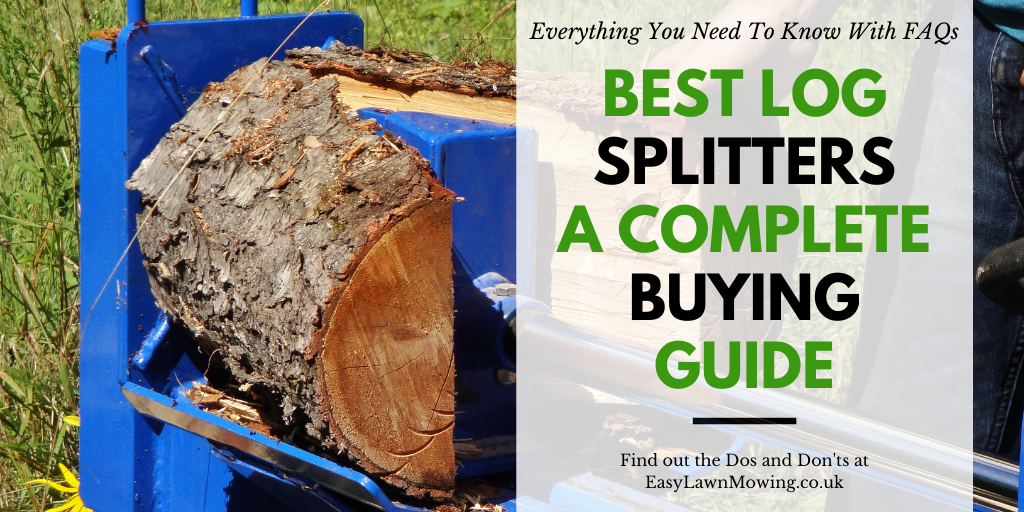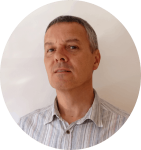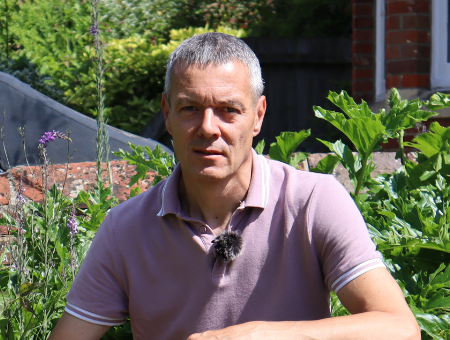Introduction To The Best Log Splitters
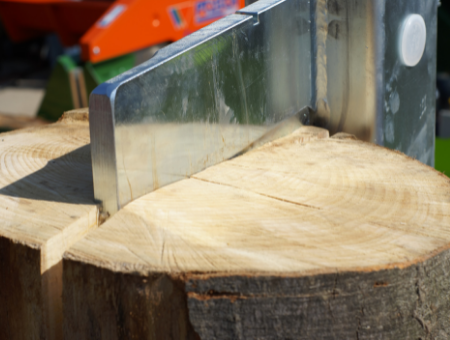
While it is possible to purchase split logs from many retailers, they are often quite costly. Whether you are buying unsplit logs or sourcing your own wood, you will need to split it before it goes on the fire. Unlike generations in the past where an axe, some serious stamina and a lot of time would have been required, modern consumers have the option of using a log splitter.
But for many people, purchasing a log splitter tool is a once in a lifetime thing and so it can be a little confusing knowing what to look for. In my guide to the best log splitters, I’ll be taking you through everything you need to know to make an informed choice that will see you ending up with a tool that will perfectly meet your needs.
In a Hurry?
If you are short of time, below I have shortlisted my Best Log Splitters categorised by the most popular feature.
Last update on 2024-04-27 / Affiliate links / Images from Amazon Product Advertising API
Guide To Buying The Best Log Splitter
Why Do I Need A Log Splitter?
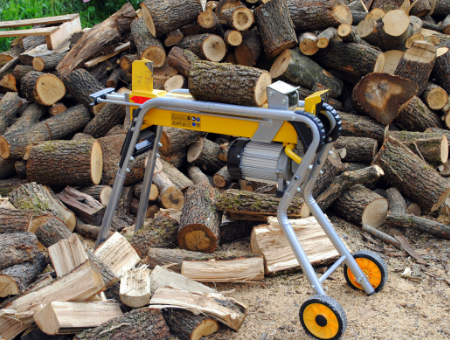
There is the risk of injury due to the sharp blade and you have to be certain that you can make a precise and clean cut, which isn’t easy without a lot of practice. Furthermore, using an axe can be a very laborious task that carries a risk of aching joints and muscles. You purchased your fire pit or wood burning stove to help you relax, what’s the sense in doing yourself a mischief just to enjoy it?
It’s also important to think about how long it takes to cut with an axe. These tools may be sharp, but they won’t get through anywhere near as many logs as a splitter would in the same amount of time. In the winter, when it’s cold, the last thing anyone wants is to have to be outside for hours chopping logs.
You might be thinking that a log splitter is a bit of an investment, especially after you’ve just had to part with so much money for your fire pit or wood burner. But when you think about the cost of split logs, you’ll soon see how the running costs could mount up. Yes, a log splitter is going to set you back a bit of money at the beginning, but in the long run, you’ll most likely save.
What Are The Different Types Of Log Splitter?
As with many tools, log splitters come in different types and it’s important to think about how you intend to use the tool to help you decide on the best model for you. In the main, there are three types of log splitter each with its own advantages.
Tractor Mounted Log Splitters

Typically, I’d recommend this type for commercial needs or for people who need to cut a lot of logs in any one session.
Towable Log Splitters
If you like the idea of having a portable log splitter, but don’t quite need the capacity that a tractor splitter is suitable for then you might choose a towable log splitter. These can still be taken to the location of the wood, but aren’t quite as large. They’re great for people who have lots of land or for commercial users such as tree surgeons.
Workshop Log Splitters
If you only need to split small amounts of wood and don’t want to do it on location, then you may find that a workshop log splitter is the most viable option. These tools are fixed in your workshop so cannot be taken on the go.
This does mean that you’ll need to transport the logs to the splitter, which could be problematic. However, again, I’ll stress that, for a domestic user that doesn’t need massive amounts at once, it’s a great option.
Horizontal Or Vertical?
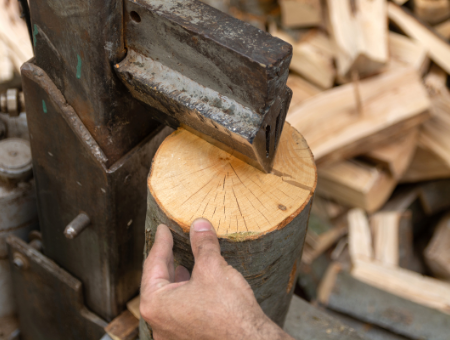
A horizontal log splitter is a much more affordable option and so is usually preferred by domestic users. What’s more, they have a compact design which is great if you’re limited on space. You can use this type of splitter either on a workbench or just on the floor – you’ll load the logs horizontally meaning it’s incredibly easy to use. If you prefer, it is also possible with some models to buy a stand for the log splitter, although some come with one as standard. Generally speaking, these are quick and convenient tools with some being able to cut up to 100 logs an hour!
On the other hand, the vertical log splitter is better when you have more challenging or larger tasks. This might be higher quantities of logs or bigger individual logs. In any case, a vertical splitter will make light work of the job.
They’re normally reserved for commercial use as they are far greater in size and so need a dedicated space for storage, not to mention the fact that moving them is quite demanding.
Choosing The Right Power
As with many other outdoor tools, log splitters can be powered in different ways. How you intend to use the tool will help you to determine the best type of power. There are four power sources to choose from.
Petrol Log Splitters
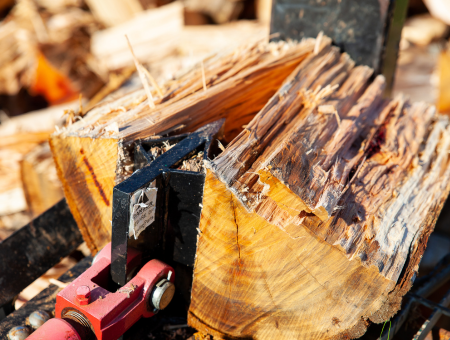
The issue with petrol log splitters, however, is that you’ll need to be prepared to perform regular maintenance. Just like other petrol powered tools such as mowers and trimmers, the engine needs to be well looked after. It isn’t rocket science, but does take a bit of getting used to, if you haven’t worked with petrol tools before. You also may wish to consider whether you have the time to dedicate to the annual maintenance.
Electric Log Splitters
When you’re shopping for a domestic log splitter, you’ll notice that most tools are powered by electricity. This is because they require far less maintenance and are beautifully easy to use. However, this does come at the sacrifice of power.
Of course, they’re not useless and will split your logs nicely, but compared to the power of petrol, they just don’t measure up. This also means that the size of the logs you can cut with an electric tool is somewhat limited.
That said, where user friendliness is concerned, the electric log splitter reigns supreme. It is a quiet tool that is super easy to operate and they don’t give off any harmful fumes, which is a plus for everyone.
Hydraulic Log Splitters
Now, before I get into the nitty gritty of the hydraulic log splitter, I have to point out that these tools will be powered by either petrol or electric, the difference is that this power source controls a hydraulic pump. You’ll first need to think about whether you prefer petrol or electric by considering the points I have discussed above.
The hydraulic log splitter uses the pump to force the splitter through the wood. You might compare it to a powered axe and the power demonstrated by these machines is enormous, hence why they are a little pricier.
Manual Log Splitters
Why pay for power when you aren’t going to be doing that much splitting? If you only need to cut small logs and very few of them, then a manual log splitter might be the right choice for you.
These tools generally require the user to chop the logs into smaller pieces before splitting them. But this depends on the capacity of the machine compared with the size of the logs you want to split. There are some that can handle larger logs, but as a general rule, you’ll need to go for smaller ones.
One of the greatest benefits of using a manual log splitter is that these are very low maintenance and portable tools. What’s more, they’re the most affordable type, so if you are working to a budget, it could be tempting. A good manual log splitter is designed in such a way that only requires limited amount of force from the operator in order to split the log.
What Type Of Logs Are You Cutting?

Generally speaking, you will either be cutting green or seasoned wood with your splitter. Seasoned wood is harder and more mature, but due to a lack of moisture, there is a greater chance of the wood breaking, splintering and splitting where you don’t want it to. However, this does mean that the wood is much easier to cut and even when you use a manual tool, you’ll find it cuts right through with very little effort. Below is a chart that shows the amount of force needed to cut different diameter logs depending on whether or not they are green or seasoned.
On the other hand, green wood contains a lot of moisture and this makes it more challenging to cut, so you’ll need a splitter whose power is compatible with this need. It is widely considered that a hydraulic splitter will deliver the best performance when cutting green wood thanks to its superior power.
You will need to think about the weight and width of the logs to determine the best type of splitter. It can be easy to assume that cutting thinner logs would mean that the weight is lower, but this isn’t always the case. It is possible for thinner logs to be very dense and heavy. So do keep this in mind when choosing.
Another key point to think about when you are buying your log splitter is the maximum power of the device. You’ll usually see this given in tonnes, the higher the value, the more the machine can handle. Vertical splitters usually have much greater capabilities than their horizontal counterparts, so this is something else to consider. When looking for a commercial log splitter or one that needs to cut larger logs, you’d typically want to go for something up to and beyond 25 tonnes.
| Diameter of Log | Minimun Force |
|---|---|
| 15cm Seasoned (6 inches) | 6 Ton |
| 30cm Seasoned (12 inches) | 7 Ton |
| 30cm Green (12 inches) | 16 Ton |
| 60cm Seasoned (24 inches) | 20 Ton |
| 60cm Green (24 inches) | 30+ Ton |
Conclusion
A log splitter is an incredibly useful tool for businesses and commercial situations, but can come in just as handy for domestic users who want to save money on wood for their wood burning stoves and fire pits. There are several different types of log splitter and they’re all powered using different methods, so it is important to think about your requirements before committing to any particular model.
Log Splitter FAQs
Do You Need To Use A Log Splitter On Level Ground?
The force of a log splitter is pretty great and while this is excellent for splitting logs, it can be incredibly dangerous. If the machine recoils, this can mean that it can move towards you or at, worse, tip over. For this reason, it is imperative that you always place the log splitter on a level surface. Some log splitters come with a work bench or stand and this offers the most stable surface with a much lower risk of accidents.
What Is The Most Powerful Log Splitter?
There are many powerful log splitters out there, but how much force any tool can generate is largely in relation to the way that it is powered. For example, petrol powered log splitters are some of the most powerful options available and are ideal for commercial situations, or where thicker diameter logs need to be cut. In some cases, these mighty machines will exert forces in excess of 20 tonnes, making them the most powerful log splitters on the market.
How Do Log Splitters Work?
Log splitters usually work using a hydraulic pump. This pump is triggered by a valve which then sends the hydraulic fluid from the tank to the hydraulic cylinder. This motion then pushes the log along the splitter and towards the blade. Once the log has been split, the hydraulic pump moves in reverse, sending fluid back and retracting the machine back to its original position.
Do I Have To Sharpen A Log Splitter?
The blade on a log splitter is commonly known as a splitting wedge. The great thing about these tools is that the splitting wedge should never need to be sharpened. However, this is only true when the tool is used correctly. You should never attempt to split anything other than wood; the manufacturer will provide details of the types of wood you can split and this should always be adhered to.
Why Is My Log Splitter Wedge Not Cutting?
If your log splitter stops cutting but it appears that everything else is working as it should be, then the problem may not be with the machine but the way that the log has been loaded. The first thing you will need to do is check that the log is not sitting at an angle, but you’ll also want to make sure that the log is not too long for the machine. If there aren’t any problems here, then it might be an issue with the wedge. The wedge can be removed and sharpened if necessary. That said, provided you only cut the types of wood that the log splitter is designed to work with, the wedge should remain sharp.
Why Is My Log Splitting Shaking When I Use It?
Sometimes, you might notice that your log splitter shakes or vibrates during use and this might be a sign that the hydraulic fluid needs to be topped up. You should make it a habit to check the fluid levels before each use and add extra fluid if it is needed. However, if you find that the fluid levels are OK, it could be an issue with air in the lines. In order to overcome this problem, you will need to open the bleed valve and move the pressure plate backwards and forwards a handful of times, which should get rid of any air. After doing this, make sure that you retighten the valve and give the fluid level a final check.
Why Do I Need A Log Splitter?
You might think that splitting logs manually with an axe is the most affordable way of doing this job and while that is true, it’s also the most time consuming method. One of the main advantages of the log splitter is that it will save you a lot of time and you will be able to cut many more logs in any given time frame than you would doing the work by hand. A log splitter will also save you money when it comes to buying logs, especially if you regularly use an appliance like a wood burning stove. Pre cut, seasoned logs can be pretty pricey so preparing your own is a thrifty option.
What Should I Look For In A Log Splitter?
I have a detailed guide on buying a log splitter above, but in short, when shopping for a log splitter you will need to consider how you intend on using the tool. You’ll need to choose one that suits the size of the logs you typically cut, as each tool will have a maximum capacity. It’s also a good idea to consider which type of power will suit your needs best and how much pressure the log splitter exerts when cutting.
Can I Use An Electric Log Splitter In The Rain?
Water and electricity do not mix, so if you own an electric log splitter, you should never use this in wet conditions. If the weather turns while you are using your log splitter outdoors, I would highly recommend stopping what you are doing and returning the tool indoors. It can be useful to have a dedicated outbuilding or shed hooked up to power so that you can safely use the log splitter inside. Always refer to the operating instructions with regards to using your log splitter safely.
Are Log Splitters High Maintenance?
While a log splitter might look like a pretty simple tool, the way that it works is quite mechanical and so owning one of these devices does come with a degree of responsibility where maintenance is concerned. However, don’t let that put you off; the type of log splitter you choose will determine how much work it takes to keep it running well. For example, petrol powered log splitters will have the added onus of oil changes and the like, whereas an electric log splitter won’t need this. For hydraulic log splitters, you will need to change the fluid and the fluid filter annually as well as inspecting the tool for leaks. This check should be carried out before you use the log splitter, but things like changing the engine oil on petrol models will only need to be done around once a year. Of course, this depends on how heavily you use the tool and your owner’s manual will give you more specific information.
What’s The Difference Between A Vertical And Horizontal Log Splitter?
As you might imagine, a vertical log splitter splits the logs vertically, while a horizontal one splits the logs horizontally. However, the way that each of these tools is used is what really sets them apart from one another. A vertical log splitter is generally used for more heavy duty work and for splitting large logs. This is because less handling is involved and you’ll much more easily be able to work with logs that are in excess of 50cm. Normally, a vertical log splitter will have a guide that keeps the wood in place as it is cut. On the other hand, a horizontal log splitter is ideal for smaller logs that measure up to 50cm, although most average models will be able to work with logs around 30cm. This is a better option for domestic users. However, unlike the vertical log splitter, the horizontal version requires more handling by the user to get the wood into position.
What’s The Difference Between A Half Beam And Full Beam Log Splitter?
The key difference between a half beam and a full beam log splitter is where the cylinder is mounted. On a half beam log splitter, the cylinder is mounted on the centre of the beam whereas for full beam log splitters, it is connected to a point at the front of the machine. Many people are under the impression that half beam log splitters are the less powerful of the two types, but while there are a lot of differences between the tools, power is not one. Half beam log splitters are typically easier to use and are more ergonomically designed. On the other hand, the full beam log splitter is ideal if you need to tow the machine to various locations as they are much more stable. In general, you can expect to pay more for a full beam log splitter, which is why these tools are usually favoured by commercial users, whereas half beam splitters are used more by domestic users.
Can You Split Wood After Rain?
Splitting wood can be made much easier when it is damp, so splitting your logs after it has rained may be beneficial. Log splitters are incredibly powerful tools that are designed to cut through even the toughest wood, so even if the wood is dry, you shouldn’t have much of a problem. Don’t confuse this with seasoned and green wood cutting ability. For more information see the chart above. However, you should keep in mind that, if you choose to cut wet wood, you will need to wait longer for it to dry out before you can use it. Note that attempting to burn wet wood will result in a lot of smoke and fumes; and that’s even if you can get it going in the first place.
What Does The Tonnage Of A Log Splitter Mean?
When you look at the details of any log splitter, you will notice that it tells you how many tonnes the tool is. This has nothing to do with the weight of the tool, which might be a common mistake, but is actually to do with how much force the log splitter can exert. The ram, which is what guides the log towards the wedge, will push the log with a certain amount of force and this is measured in tonnes. Most domestic log splitters will be between 4 and 6 tonnes, whereas some commercial models might be 22 tonnes. The higher this number, the more force the log splitter uses and this means that it can split larger, more robust pieces of wood.
Can You Store A Log Splitter Outside?
If you are using an electric log splitter, it is not a good idea to store this outdoors as any rain or moisture in the air will damage the power system and render the tool useless. Not to mention that using the splitter in the rain comes with a risk of electric shock. You should move your log splitter indoors when it is not in use as this will offer the best protection. Some people might leave petrol powered log splitters outdoors and simply cover them over, but this still exposes them to the elements to some degree meaning that metal components may rust more quickly and the mechanical aspects may become damaged.
As a seasoned expert in the field of garden power tools, I have dedicated over a decade to working with and reviewing a wide variety of lawn mowers. My extensive experience has allowed me to gain a deep understanding of the benefits and limitations of different types of mowers and garden tools.
Over the years, I have honed my skills in writing informative articles and creating helpful videos for various blogs and publications. This has given me the ability to not only recognise what makes a good lawn mower, but also to help you choose the perfect garden tool for your specific needs and requirements.
With my wealth of knowledge and expertise, I am confident that I can provide you with valuable insights and recommendations when it comes to selecting the right lawn mower for your lawn. So, whether you're looking for a battery cordless, electric, petrol, or robotic mower, you can trust in my expertise to guide you towards the best option for your garden.

